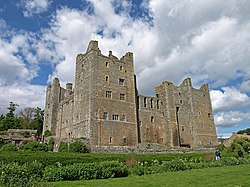Bolton Castle: Difference between revisions
Created page with "{{Infobox castle |name=Bolton Castle |county=Yorkshire |riding=North |village=Castle Bolton |picture=Bolton_Castle,_at_Castle_Bolton_-_geograph.org.uk_-_1390969.jpg |picture c..." |
No edit summary |
||
| Line 15: | Line 15: | ||
|website=[http://www.boltoncastle.co.uk/ boltoncastle.co.uk] | |website=[http://www.boltoncastle.co.uk/ boltoncastle.co.uk] | ||
}} | }} | ||
'''Bolton Castle''' is a 14th-century castle in the [[North | '''Bolton Castle''' is a 14th-century castle in the [[North Riding of Yorkshire]], at [[Castle Bolton]], a village which takes its name from the castle. It is in [[Wensleydale]]. | ||
The castle is a Grade I listed building and a Scheduled Ancient Monument.<ref name=Pastscape>{{pastscape|48868|mdesc=Bolton Castle|accessdate=24 February 2008}}</ref> | The castle is a Grade I listed building and a Scheduled Ancient Monument.<ref name=Pastscape>{{pastscape|48868|mdesc=Bolton Castle|accessdate=24 February 2008}}</ref> | ||
Latest revision as of 20:53, 21 February 2016
| Bolton Castle | |
|
Yorkshire | |
|---|---|
 The castle from the south | |
| Location | |
| Grid reference: | SE033918 |
| Location: | 54°19’19"N, 1°56’53"W |
| Village: | Castle Bolton |
| History | |
| Built 1378-1379 | |
| Information | |
| Owned by: | Lord Bolton |
| Website: | boltoncastle.co.uk |
Bolton Castle is a 14th-century castle in the North Riding of Yorkshire, at Castle Bolton, a village which takes its name from the castle. It is in Wensleydale.
The castle is a Grade I listed building and a Scheduled Ancient Monument.[1]
The castle was damaged in the Civil War, but much of it remains. It has never been sold and is still in the ownership of the descendants of the Scrope family.
History
The castle was built between 1378 and 1399 by Richard, 1st Baron Scrope of Bolton, and is an example of a quadrangular castle. The licence to build it was granted in July 1379 and a contract with the mason John Lewyn was made in September 1378. Construction was reputed to cost 18,000 Marks. The 16th-century writer John Leland described 'An Astronomical Clock' in the courtyard and how smoke was conveyed from the hearth in the hall through tunnels. Bolton Castle was described by Sir Francis Knollys as having 'The highest walls of any house he had seen'.
In 1536 John, 8th Baron Scrope supported the Pilgrimage of Grace rebellion against the religious reforms of King Henry VIII and gave Adam Sedbar, Abbot of Jervaulx sanctuary in the castle. In consequence John Scrope had to flee to Skipton pursued by the King's men but Abbot Sedbar was caught and executed. In retribution the king ordered Bolton castle to be torched, causing extensive damage. Within a few years the damage had been repaired and Sir John had regained his seat in Parliament.
Mary, Queen of Scots, at Bolton
Mary, Queen of Scots stayed at Bolton for six months. After her defeat in Scotland at the Battle of Langside in 1568 she fled to England, posing a threat to the position of the Protestant Queen Elizabeth I. Mary was initially held at Carlisle Castle under the watch of Henry, 9th Baron Scrope, but Carlisle proved unsuitable and in July 1568 Mary was moved to Bolton. Mary was given Henry Scrope's own apartments in the South-West tower. Of her retinue of 51 knights, servants and ladies-in-waiting only 30 of her men and six ladies-in-waiting were able to stay in the castle, the rest taking lodgings nearby. Her household included cooks, grooms, hairdresser, embroiderer, apothecary, physician and surgeon. Bolton Castle was not initially suitable for housing a Queen, so tapestries, rugs and furniture were borrowed from local houses and nearby Barnard Castle in County Durham. Queen Elizabeth herself loaned some pewter vessels as well as a copper kettle.
Mary was allowed to wander the surrounding lands and often went hunting. Her prime occupation while at the castle was having her hair done by her friend Mary Seton. Sir Francis Knollys, whom Mary nicknamed 'Schoolmaster', taught her English as spoken in England, as the Queen only spoke French, Latin and Scots. She even met with local Roman Catholics, something for which Knollys and Scrope were severely reprimanded. In January 1569 Mary left Bolton Castle for the last time, being taken to Tutbury in Staffordshire where she spent much of the 18 years before her execution in 1587.
Later history
After the death in 1630 of Emanuel Scrope, 1st Earl of Sunderland, without any legitimate children, Bolton Castle was inherited by Mary the eldest of his three illegitimate daughters. She married Charles Powlett, 6th Marquess of Winchester and 1st Duke of Bolton.
The castle is currently owned by their descendant, Harry, the eighth Baron Bolton, who resides at nearby Bolton Hall, which was originally built in 1675. Bolton Castle is run by his son and daughter-in-law, Thomas and Katie Orde-Powlett. There is also a garden including a maze, herb garden, wild flower meadow, rose garden and a vineyard on the site.
Film location
Several film and television productions have used Bolton Castle as a location, including:
- Ivanhoe (1952 film)
- Elizabeth (1998 film)
- Television series:
- Heartbeat
- All Creatures Great and Small
Outside links
| ("Wikimedia Commons" has material about Bolton Castle) |
References
- Fry, Plantagenet Somerset (1980). The David & Charles Book of Castles. Newton Abbot: David & Charles. ISBN 0-7153-7976-3.
